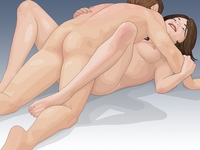
Photo from wikipedia
Background and Objectives: Urinary incontinence is the accidental loss of urine that can occur at any age, especially among women over 50; however, its prevalence is increasing. This study aimed… Click to show full abstract
Background and Objectives: Urinary incontinence is the accidental loss of urine that can occur at any age, especially among women over 50; however, its prevalence is increasing. This study aimed to assess the efficacy and safety of a device that uses Top Flat Magnetic Stimulation for the management of women with mixed urinary incontinence. Materials and Methods: A total of 50 female patients underwent a total of six treatment sessions performed twice a week for three consecutive weeks, for 28 min. Three questionnaires were used for the evaluation of the urinary improvements: Urinary Incontinence Short Form (ICIQ-UI-SF), Incontinence Questionnaire Overactive Bladder Module (ICIQ-OAB), and Incontinence Impact Questionnaire-Short Form (IIQ-7). The questionnaires were compiled immediately before each treatment, within the treatment period (until the sixth treatment session), and up to 3 months of follow-up. Results: Improvement in quality of life is observed according to the results of the questionnaire, already after six sessions and at three months follow-up. ICIQ-UI-SF’s average score at baseline was 20.2 (±1.1), and it significantly declined (p < 0.01) to 1.8 (±2.4) after six sessions and to 4.8 (±2.8) at 3 months follow-up; ICIQ-OAB’s average score significantly decreased (p < 0.01) from 10.4 (±3.2) at baseline to 1.4 (±0.8) after six sessions and 2.3 (±1.6) at 3 months follow-up. IIQ-7’s average score significantly decreased (p < 0.01) from 20.2 (±1.7) at baseline to 0.4 (±0.5) after six sessions and to 4.7 (±2.8) at 3 months follow-up. Conclusions: Our results suggest that Top Flat Magnetic Stimulation technology can reduce mixed urinary incontinence symptoms for all women examined, leading to an improvement in the patient quality of life and patient awareness of their pelvic floor area with good results.
Journal Title: Bioengineering
Year Published: 2022
Link to full text (if available)
Share on Social Media: Sign Up to like & get
recommendations!